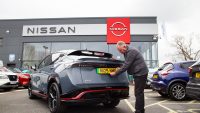 The head of Renault’s electric vehicle programme tells James Batchelor that affordability is key as the French firm begins its assault on the growing market for EVs.
The head of Renault’s electric vehicle programme tells James Batchelor that affordability is key as the French firm begins its assault on the growing market for EVs.
In a full year, how many Fluences are you expecting to sell?
We don’t give out sales predictions, but I can say that it will be in the hundreds rather than the thousands. Our volume aspirations for 2013 will sit with Zoe because it is in the B-segment and we believe it to be the definitive EV. So, from the point of view of Fluence, it is our first electric car, it is a derived product, and the big question mark is whether there will be an appetite for a C-segment EV.
Even for the Nissan Leaf which has been a success, consumers get to a point where it is a big leap of faith for them to treat a C-segment EV as their primary car. Our smaller EVs will be more popular because their usage pattern will be different – they will often be used as a second car.
In contrast to the quirky Nissan Leaf, do you feel you’re at a disadvantage in having a ‘derived product’?
I could put a counter argument to you here and say that I think for the number of people who are attracted to the look of the Leaf, the more conservative styling of the Fluence will still appeal. It is horses for courses – you are not making a big lifestyle statement by driving a Fluence, but if you are slightly more conservative and want value for money the car will appeal.
 Why is the Fluence noticeably cheaper than other EVs?
Why is the Fluence noticeably cheaper than other EVs?
It is due to Renault’s attitude of affordability for all. For the same price, customers will be able to have a similarly-specced Megane because we see it as an equivalent. A lot of people love to highlight that the price of the Fluence is ‘battery not included’, but £70 is also the price of a tank of fuel.
Do you think you will be selling more Kangoo ZE vans than Fluences?
Much more. I think with the Kangoo, the market has been in a period of suspended animation for the last three months while everyone has been waiting to see what the Government incentive will be. I am now expecting some large orders to come in – we won’t be talking thousands and thousands, but I am hoping to sell a four-figure amount this year.
How many EV dealers do you now have?
We have recently appointed our 22nd and each one has two trained sales people – commonly a showroom person and a fleet person. We have done this because the Kangoo makes more sense as a B2B sale – and there are two workshop people. Even though dealership staff have been to Seville to get their training, we will be dealing with the most informed customer we’ve ever dealt with. Because of this, we will have to continue to bombard them with training and sales messages.
This year we are inviting dealers to come on board with our EV programme – next year it will be a franchise standard. For our current 22 dealers, we only expect them to have a Fluence demonstrator, but for the dealers who are coming on board, we would like them to have a Kangoo demonstrator, and next year we would expect our dealers to be running a Kangoo and a Zoe demonstrator. For the Twizy, most of our dealers will have one as a demo because of its sexiness.
Will you be installing charging points at every dealer?
Ultimately the goal is that by 2013 every dealer with us will be selling electric vehicles, and for us the definition of selling EVs is technical and sales knowledge, plus charging facilities. It may or may not be three 22Kw chargers that are expensive to install, but there may be a tailored charging point system so that every dealer can afford them.
 Is the quirky Twizy a good example of the future direction of Renault EVs?
Is the quirky Twizy a good example of the future direction of Renault EVs?
I don’t think it’s just a Renault thing, but a market trend. Nano, or ultra-compact cars, will become more popular in the future and will join already established products by Tata, Gordon Murray and Smart. There is an increasing number of products coming into that sector because they are perfectly designed for the city, and consumers are beginning to realise that they don’t need to lug around five people and 300 litres of luggage.
All we are doing is getting in at the start of something that is happening in the market, and we are doing it in a affordable way – and, more importantly, we are doing it all-electric.
Your Alliance partner Nissan has been in the EV market for more than a year. Are you joining late or at the right time?
I think we’re joining it at the right time. Eighteen months ago, before the Leaf was launched, someone asked me whether I would like to swap places with the guy at Nissan as, on the face of it, he was launching a very good-looking car nine months ahead of me launching a conventional electric van.
Although I made a brave statement at the time saying ‘No, I would not’, deep down I probably did envy him. But in reality I would rather be where I am today as Nissan had to do a lot of trailblazing and had to deal with a lot of scepticism when they launched the Leaf. As the EV market gains momentum, I think 2012 is a good year to be joining it – 2014 is too late as the runners and riders will have started to establish themselves.
































